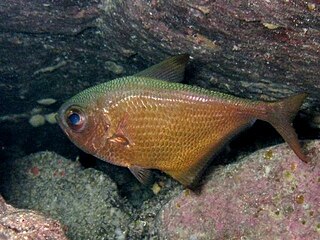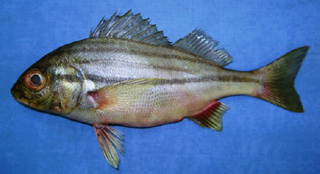
Grunion are two fish species of the genus Leuresthes: the California grunion, L. tenuis, and the Gulf grunion, L. sardinas. They are sardine-sized teleost fishes of the New World silverside family Atherinopsidae, found only off the coast of California, USA, and Baja California, Mexico, where the species are found on both the Pacific Ocean and Gulf of California coasts. Many people enjoy catching grunion at events called "grunion runs."

The Atlantic silverside, also known as spearing in the northeastern United States, is a small species of fish that is one of the most abundant fish species present in estuarine habitats along the Atlantic coast of North America. It is a common subject of scientific research because of its sensitivity to environmental changes. According to the IUCN Red List, this species is stable and has no major threats to its populations, so it is marked Least Concern. Despite being an extremely common species, most individuals die after one year once they migrate offshore, but a few will make it to two years. The fish is mostly translucent, with white coloring on the anterior end of the body and brown speckling on the top of the head, posterior scales on the back, and near the jaw. A distinctive silver band runs the length of the fish, next to the lateral line. Their mouths are large compared to other Menidia species, and their first dorsal fin are placed more posteriorly than other silversides.

The Old World silversides are a family, Atherinidae, of fish in the order Atheriniformes. Atherinidae are abundant and considered bony fish (teleost) that are widespread globally, living in rivers, estuaries, and coastal waters. They occur worldwide in tropical and temperate waters. About two-thirds of the species are marine, and the remainder live in fresh water. The 74 species are in 13 genera. The genus Craterocephalus is the most diverse with 25 species. Four genera are monotypic.

The Lessepsian migration is the migration of marine species along the Suez Canal, usually from the Red Sea to the Mediterranean Sea, and more rarely in the opposite direction. When the canal was completed in 1869, fish, crustaceans, mollusks, and other marine animals and plants were exposed to an artificial passage between the two naturally separate bodies of water, and cross-contamination was made possible between formerly isolated ecosystems. The phenomenon is still occurring today. It is named after Ferdinand de Lesseps, the French diplomat in charge of the canal's construction. The term was coined by Francis Dov Por in his 1978 book.

Atherinomorus is a genus of silversides in the family Atherinidae. They are found across the Indo-Pacific and one species in the western Atlantic ocean.
Giacomo Bernardi is a Professor of Ecology and Evolutionary Biology at University of California Santa Cruz. He earned his B.A., M.S., and Ph.D. at the University of Paris and did post-doctoral work from 1991 to 1994 at Hopkins Marine Station at Stanford University.
The Darling River hardyhead is a species of fish in the family Atherinidae endemic to Australia. The species name amniculus is from the Latin meaning a small creek or stream, in reference to the habitat where these fish are often found.
The Dalhousie hardyhead is a species of silverside in the family Atherinidae. It is endemic to the warm waters of Dalhousie Springs in the Lake Eyre basin, Australia, along with the similar Craterocephalus gloveri. It inhabits shady areas in tropical freshwater streams at 20-39 °C, but has been recorded at 41.8 °C. Its food consists of gastropods, aquatic plants, green filamentous algae, detritus and small invertebrates; food is mainly taken from the substrate.

The northern whiting, also known as the silver whiting and sand smelt, is a marine fish, the most widespread and abundant member of the smelt-whiting family Sillaginidae. The northern whiting was the first species of sillaginid scientifically described and is therefore the type species of both the family Sillaginidae and the genus Sillago. The species is distributed in the Indo-Pacific region from South Africa in the west to Japan and Indonesia in the east. The northern whiting inhabits coastal areas to 60 m, but is most often found in shallow water around bays and estuaries, often entering freshwater. It is a carnivore, taking a variety of polychaetes and crustaceans. The species is of major economic importance throughout the Indo-Pacific. It is most frequently taken by seine nets and cast nets and marketed fresh.
Hardyhead refers to a number of species of fish in the family Atherinidae, including:
Atherion is a small genus of silversides, known as the pricklenose silversides. It is the only genus in the family Atherionidae. Other authorities classify this as a monogeneric subfamily, Atherioninae, of the Atherinidae, while others include it within the subfamily Atherinomorinae. They have an Indo-Pacific distribution.

Ostorhinchus fasciatus, commonly known as the broad-banded cardinalfish, is a marine fish native to the Indian and Pacific Oceans which is a Lessepsian migrant to the eastern Mediterranean through the Suez Canal from the Red Sea, it was first recorded off Israel in 2008 and has now reached the southern coast of Turkey. It has a number of vernacular names including barred striped cardinalfish, four-banded soldier-fish, striped cardinalfish and twostripe cardinalfish.

Sphyraena chrysotaenia, the yellowstripe barracuda, is a species of predatory, ray finned fish from the family Sphyraenidae which is found in the Indo-West Pacific region. It has entered the Mediterranean Sea from the Red Sea through the Suez Canal as a Lessepesian migrant and is now an important species in the fisheries of the eastern Mediterranean.

Terapon puta, the spiny-checked grunter, three-lined grunter, small-scaled banded grunter, small-scaled terapon, squeaking perch or two-lined grunter, is a species of fish from the Indo-Pacific region, it is a member of the grunter family, Terapontidae. It has also spread into the eastern Mediterranean Sea from the Red Sea through the Suez Canal, a process known as Lessepsian migration.

Stephanolepis diaspros, commonly known as the reticulated filefish or the reticulated leatherjacket, is a species of bony fish, a ray-finned fish in the family Monacanthidae. Its natural range is the western Indian Ocean but it is also one of the species which has colonised the Mediterranean through the Suez Canal by Lessepsian migration from the Red Sea.

Pempheris mangula, the black-edged sweeper, Moluccan sweeper or black-margin bullseye is a species of Indo-Pacific sweeper from the family Pempheridae. The history of the identification of the Indo-Pacific sweepers is complex and this species has been identified as the "Pempheris vanicolensis" which has colonised the Mediterranean Sea from the Red Sea via the Suez Canal by Lessepsian migration but this identification is not universally accepted.

Herklotsichthys punctatus, the spotback herring or spotted herring, is a species of herring from the family Dorosomatidae. It is endemic to the Red Sea and likely entered the Mediterranean Sea via the Suez Canal and is now common on the Levantine Basin.

Pomadasys stridens, the striped piggy or lined piggy, is a grunt from the western Indian Ocean and is one of a group of Indo-Pacific marine species which have colonised the Mediterranean Sea through the Suez Canal from the Red Sea, a process known as Lessepsian migration.

Atherinomorus insularum also called Hawaiian silverside or 'iao in Hawaiian is a species of fish in the family Atherinidae endemic to Hawaii.















